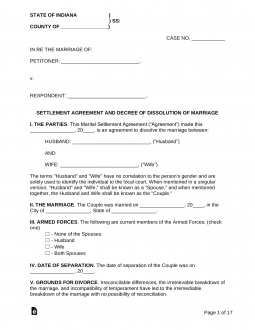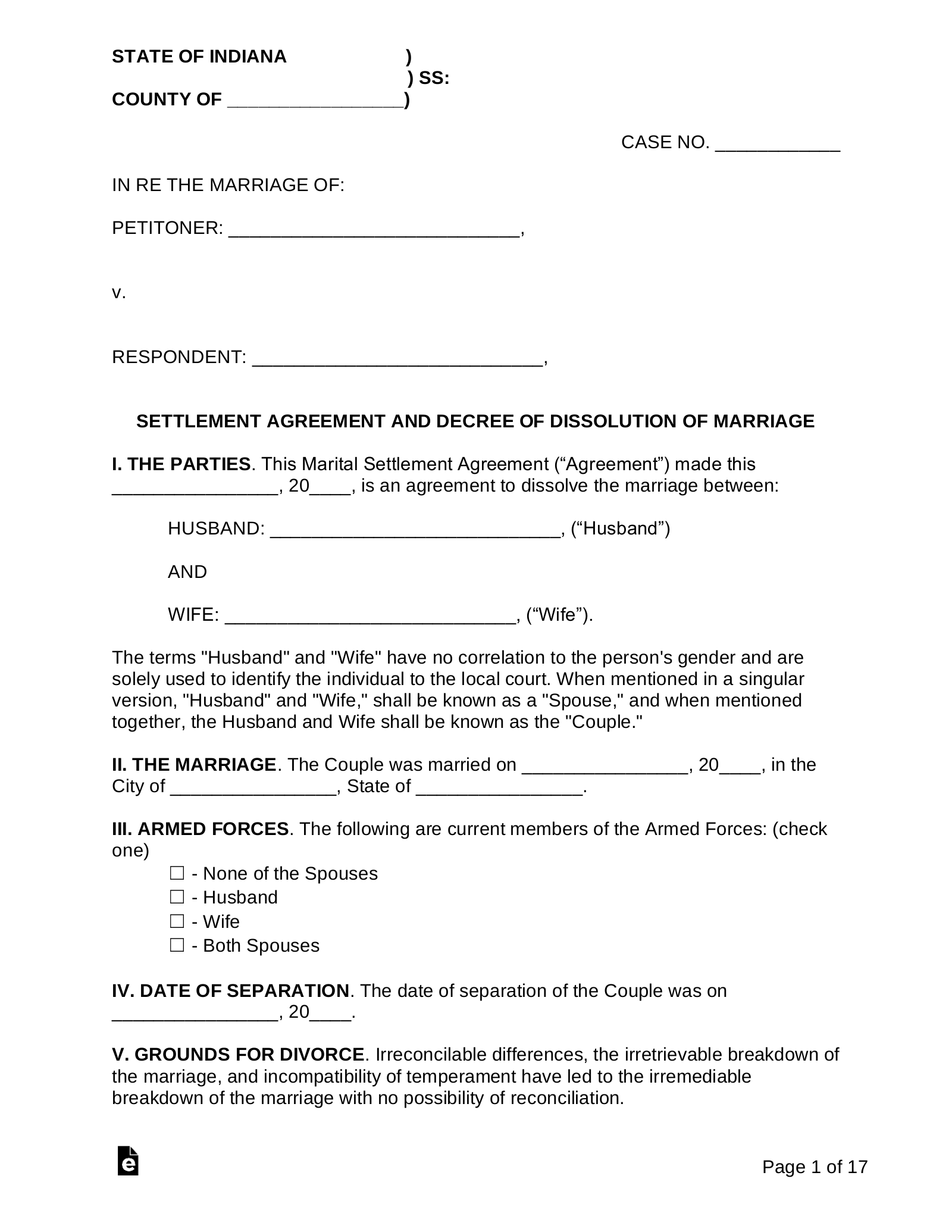Updated February 08, 2024
An Indiana marital settlement agreement is used to set forth conditions for divorce in relation to alimony payments, minor children, and the division of personal property and assets. A settlement agreement expedites the legal proceedings by proving to the court that a mutually acceptable arrangement has been reached and that both parties affirm their decision to divorce. In the document, the couple will specify how they intend to handle child support payments, child custody, marital property, health insurance policies, and retirement plans. If the parties disagree over certain issues, a mediator’s services may be employed to help establish a fair arrangement. The conditions of the agreement will be legally binding once signed, although the divorce itself will not be finalized until a judge issues a Decree of Dissolution of Marriage.
Table of Contents |
Divorce Laws
Statutes – Title 31, Article 15 (Family Law: Dissolution of Mariage and Legal Separation)
Alimony (§ 31-15-7-2) – Alimony, referred to as “spousal maintenance” in Indiana, may be awarded by the court for an indefinite period when:
- A spouse lacks the physical or mental capacity to support him or herself;
- A spouse is the caretaker of a child whose physical or mental condition requires them to forgo employment, and the spouse is void of sufficient property to support their needs.
Indiana offers another form of alimony known as “rehabilitative spousal maintenance,” which may be granted for a period of three (3) years or less. The court will consider the following when awarding this type of alimony:
- The level of education received by each spouse;
- Whether a spouse interrupted their employment, training, or education as a result of their child care and/or homemaking responsibilities;
- The capacity of a spouse to earn income; and
- The time and expense needed to obtain adequate training or education for employment.
Alimony Calculator – Calculators.law
Child Support (§ 31-16-6-1) – Indiana courts use the Child Support Rules and Guidelines when awarding child support.
Child Support Calculator – https://www.in.gov/judiciary/2625.htm
Division of Property (§ 31-15-7-5) – Indiana uses equitable distribution to divide property, meaning that marital property will be divided fairly but not equally.
Grounds for Divorce (§ 31-15-2-3) – A divorce may be decreed upon the following grounds:
- Irreparable collapse of the marriage;
- Conviction of a felony;
- Impotence; or
- Incurable insanity for at least two (2) years.
Interim Support (§ 31-15-4-1) – Either spouse may request temporary alimony or child support during the period while a divorce case is pending.
Residency (§ 31-15-2-6) – Before filing for divorce, one (1) of the spouses must have been a resident of Indiana for six (6) months, and one (1) of the spouses must have been a resident of the county where the divorce is filed for three (3) months.
Divorce Forms
- Where to File – Local Clerk’s Office
- Filing Fee – The cost to file a new case in civil court is $157. If the filer opts to use the sheriff to serve the papers, the cost will be $185. Note, you can consider filing a fee waiver if you meet certain requirements under Indiana law. (source: Indianalegalhelp.org)
- How Long Does it Take? Sixty (60) days (§ 31-15-2-10)
Uncontested Divorce with No Children – Filing Packet:
- Appearance by Unrepresented Person in Civil Case
- Civil Appearance Form
- Verified Petition for Dissolution of Marriage
- Summons
- Order Setting Provisional Hearing
- Provisional Order
- Verified Waiver of Final Hearing
- Settlement Agreement and Decree of Dissolution of Marriage
Uncontested Divorce With Children – Filing Packet:
- Appearance by Unrepresented Person in Civil Case
- Civil Appearance Form
- Verified Petition for Dissolution of Marriage
- Summons
- Order Setting Provisional Hearing
- Provisional Order
- Verified Waiver of Final Hearing
- Settlement Agreement and Decree of Dissolution of Marriage
- Child Support Obligation Worksheet (not included in filing packet)
- Income Withholding Order (not included in filing packet)
How to File for Divorce in Indiana (9 steps)
- Complete the Divorce Packet
- Child Support Obligation Worksheet
- File Divorce Paperwork
- Serve Paperwork on the Other Spouse
- Financial Disclosure
- Settlement Agreement
- Waiver of Final Hearing
- Finalize Divorce
- Name Change
1. Complete the Divorce Packet
The spouse filing for divorce must fill out one (1) of the filing packets available above. The filer should review the court rules for their county to determine how many copies of each form are needed and whether any supplementary paperwork is required. To be certain that the documents have been filled out correctly, the filer can review the applicable instructional guide below.
- Uncontested Divorce with No Children – Instructions
- Uncontested Divorce With Children – Instructions
Note: The Settlement Agreement and Decree of Dissolution of Marriage must not be signed until prompted in the instructions below. In addition, the Verified Waiver of Final Hearing won’t be used until at least sixty (60) days have passed from the initial filing date of the divorce documents.
2. Child Support Obligation Worksheet

If the spouses are the parents of a minor child, a Child Support Obligation Worksheet must be filled out and included with the divorce documents. Furthermore, an Income Withholding Order will be sent to the employer of the spouse paying child support. Depending on the rules of the court, the Income Withholding Order may need to be included with the filing packet and signed by the judge handling the divorce case.
3. File Divorce Paperwork
The paperwork must be filed with a court clerk in the county where one (1) spouse has lived for at least three (3) months. The filer must also provide the clerk with two (2) stamped and addressed envelopes: one (1) with their address and one (1) with the other spouse’s address. A filing fee will be charged at this time. After submitting the paperwork and paying the fee, the clerk will stamp the documents and return them to the filer.
- The filer can request a provisional hearing before a judge. At the hearing, either spouse can ask the judge to issue an order setting forth the rights and responsibilities of each party while the divorce case is pending. To request a provisional hearing, the filer must select the applicable option in the Verified Petition for Dissolution of Marriage.
4. Serve Paperwork on the Other Spouse
One (1) set of the stamped documents must be served on the other spouse’s attorney or directly to the other spouse if they are representing themselves. The paperwork can be served by certified mail, a private process server, or the sheriff’s office. Note that a small service fee will be charged to the filer.
5. Financial Disclosure

Each spouse will need to prepare a financial disclosure that lists their assets, sources of income, and debts. It is imperative that the disclosure be as comprehensive and accurate as possible. If one spouse attempts to withhold income or assets from the other, the withholding party may face legal ramifications ranging from monetary damages to imprisonment. After preparing the disclosure, it should be delivered to the other spouse for review.
6. Settlement Agreement
The couple can begin negotiating the terms of their divorce to establish alimony (spousal maintenance), child support, child custody, and property division. If the parties cannot come to a mutual agreement, they should consider hiring a private mediator to help them reach an amicable solution. Once the negotiations are complete, the spouses can state the agreement terms in the Marital Settlement Agreement.
7. Waiver of Final Hearing
Regardless of when the couple finalizes their marital settlement agreement, the divorce won’t be official until at least sixty (60) days have passed since the initial divorce documents were submitted. After sixty (60) days, the parties must fill out the Verified Waiver of Final Hearing. This form will notify the court that the couple has settled the divorce terms and wish to waive their right to a final hearing. Once signed, the waiver must be submitted to a court clerk.
8. Finalize Divorce

After the parties have agreed to the divorce terms and have waited sixty (60) days, the judge handling the case will fill out the Settlement Agreement and Decree of Dissolution of Marriage. This document includes the conditions set forth in the Marital Settlement Agreement as well as any terms imposed upon the couple by the judge. The divorce will then be final, and the parties will be bound to the conditions stated in the Decree. Lastly, the couple must sign the Decree in the presence of a notary public.
9. Name Change
If a spouse has requested to change their last name during the divorce case, the change will be official once the Decree has been issued. The spouse can then request a certified copy of the Decree from a court clerk, which will serve as evidence of the name change. More information on the name change process can be accessed here.


